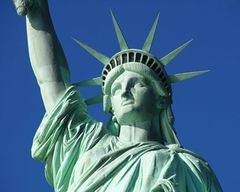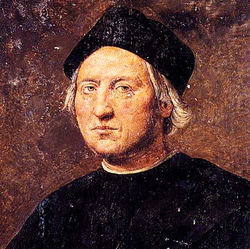User:MsuCarencro/A History Of The United States of America
“ America is the only country that went from barbarism to decadence without civilization in between.”
The history of the United States is a long and fascinating one, spanning more than three hundred years of storm adrift pilgrims, overzealous conquistadors, dead overzealous conquistadors, a bloody revolution, an even bloodier civil war, and more events that if I listed, would fill thousands of pages in a great book. If you are being poetic, the history of the country could be compared to a novel: sometimes tragic, and sometimes extremely humorous (like the War of 1812! What a joke); in a gist, the country's history can be as straight and stable as a brick wall, or uneven and undulating as the obese curves of the average American citizen. However history played out, it is an exciting adventure, from the birth of the nation, to becoming the greatest country in the world. At least that's what most Americans say; they aren't exactly known for their humility.
Before Columbus's Fateful Voyage[edit | edit source]
Before humans arrived on the North American continent, their wasn't a single shred of civilization for thousands of miles. There was nothing but the animals of the Pleistocene Epoch (such as the Dasypus bellus, and the ever popular Smilodon fatalis) roaming across the land, eating or being eaten. There were no strip malls or greasy fast food stands, only cyclopean beasts following the way of nature, relying not on tools but only on their quick wits, instincts, and 28cm canines supported by Temporal muscles strong enough to gouge your eyes off. It was a very peaceful time. The arrival of the wise Homo sapiens sapiens from Asia may have complicated the equilibrium of life during this period, which may have caused the extinction of many of the ice-age animals.
The First North Americans[edit | edit source]
Since this article is about the history of the United States, I won't elaborate on certain details, but I will try to give you a quick gist of what happened when our ancestors first came into the new world. Though scientists tend to argue amongst themselves frequently, and quite loudly too, most agree that the first North Americans arrived by crossing through Beringia, a 1,000 mile land bridge that once connected Asia to the Americas. It may have happened like this: a roving band of hunter gatherers, lets say 10,000-50,000 years ago, find a herd of game, and decide to follow it. The herd ends up crossing the land bridge, and the humans follow closely; eventually they leave Asia and reach a new continent. The people that left Asia through Beringia settled across the two continents, some making their homes up in the North like the Inuits, and some settling South in South America, such as the Mayans, Incas, and Aztecs. As we all know, the Europeans weren't too fond of the Native Americans, especially the conquistadors, who eventually destroyed the Inca and the Mayan civilizations in South America. Later in history, the Native Americans living in the US received harsh treatment and were kicked out of their lands, but that's for later on.
The Spanish In North America[edit | edit source]
Before the year 1492, there was barely, if at all, any contact between the old and the new world. Before 1492, the earliest known contact between Europe and North America was in 1003 CE, when Leif Ericson, a Norse explorer, reached the island of Newfoundland. There was actually short lived colony, L'anse aux Meadows, there, but it lasted very shortly. Europeans didn't know of the Norse voyage, and were mostly unaware of the existence of North and South America; this all changed when an Italian navigator, who was blessed with an extraordinarily catchy name, set sail to find a shorter trade route to China and India. Little did he know that he would change the course history by "discovering" the new world, and initiating the process of European colonization, which of course, led to the formation of the thirteen colonies.
Christopher Columbus's Voyage[edit | edit source]
Most of what is known about Christopher Columbus by most of the public is more fiction than reality, the prevalent view being similar to this: Christopher Columbus, who wanted to explore the world, was first turned down by the backwards Portuguese, because of their belief of the world being flat (those stupid Portuguese!). He eventually received funding from Queen Isabella of Spain and after valiantly sailing across the Atlantic, founded the new world, and discovered North America. In truth, Columbus was far less heroic than his legend. Most likely born in Genova, which is part of modern Italy, Columbus became a navigator for Portugal and planned an alternate route from Europe to Asia, after the previous land route became unsafe.
Before the Fall of Constantinople on 29 May, 1453, the passage was under the protection of the Byzantine empire, but after the Byzantine Empire was conquered, the land route became generally unsafe due to high occurrences of arrows hitting you in the eye socket during travel. Contrary to what most think, the Portugese refused to fund his journey not because they believed that the world was flat and that Columbus would fall off the Earth (in fact, most educated Europeans at the time believed that the world was a sphere; the main argument was the diameter of the Earth), but because they thought-correctly-that the diameter of the Earth was longer than Columbus thought; he thought that the Earth was about 25,000 km in diameter, at most: he was wrong by about 15,000 kilometers.
Finally, he got funding from Spain with an annual salary of 12,000 maradevis. On 3 August, 1492, Christopher Columbus, with the three famous ships, the Santa Clara (nicknamed Niña), the Santa María, and the Pinta, set sail on his first voyage to Asia. After 37 days of sailing, Columbus finally reached Asia, at least that's what he thought. Columbus actually landed on the island of San Salvador in the West Indies. Because of his mistaken belief that he landed in the Indies, he called the inhabitants "Indians". Columbus made three more voyages, but he never thought that he found a new continent, he still thought, even in death, that he landed on Asia. In 1494, the Treaty of Torsedilla, an agreement between Spain and Portugal, split up the then barely known new world for the two countries.
The Conquistadors Search For Gold[edit | edit source]
Inspired by the conquests of the Spanish Hernán Cortés and Francisco Pizarro, other conquistadors explored North America, in search for one thing: vast amounts of wealth. The explorers wanted valuable gold to fill their coffers, and they were guided by the legends of the Seven Cities of Gold. Hernando de Soto, a Spanish Explorer, wanted to find some of the rare metal and a land route to China; needless to say, he was unsuccessful, but he did discover the Mississippi River, which became an important trade route in the new world. Francisco Vásquez de Coronado y Luján, mounted an expedition to North America after Marcos de Niza returned from an expedition he dispatched them to. Marcos told of a city of vast wealth,

